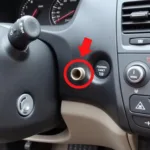The Saab 9-3, a beloved car for its unique style and performance, relies on a sophisticated computer system to monitor and regulate critical functions. At the heart of this system lies the OBD2 port, a gateway into understanding your car’s health. Whether you’re experiencing engine issues, suspecting emissions problems, or simply curious about your Saab’s inner workings, an OBD2 scanner can be an invaluable tool.
Why OBD2 Matters for Your Saab 9-3
The OBD2 system, standard in vehicles since 1996, including the Saab 9-3, continuously monitors your car’s engine, transmission, emissions system, and more. When it detects an anomaly, it generates a Diagnostic Trouble Code (DTC), a unique code stored in the car’s computer. An OBD2 scanner acts as the translator, reading these codes and displaying them in an understandable format.
Deciphering OBD2 Codes: What Your Saab 9-3 is Telling You
OBD2 codes are standardized, meaning a specific code indicates the same potential issue across different car makes and models. However, certain codes might have specific interpretations related to the Saab 9-3’s unique engineering.
For instance, a P0420 code (Catalyst System Efficiency Below Threshold) might point towards a failing catalytic converter, a common issue in older Saab 9-3 models.
Choosing the Right OBD2 Scanner for Your Saab 9-3
Not all OBD2 scanners are created equal. Basic scanners can read and clear basic codes, while more advanced models offer live data streaming, graphing capabilities, and even manufacturer-specific code definitions, particularly helpful for Saab’s sometimes-quirky systems.
Consider factors like your budget, technical expertise, and how deeply you want to delve into your Saab’s diagnostics when choosing a scanner.
Beyond Diagnostics: Unlocking Your Saab 9-3’s Potential
An OBD2 scanner isn’t just for troubleshooting. Enthusiasts can use it to monitor performance parameters like boost pressure, engine temperature, and fuel economy in real-time, enhancing their driving experience or aiding in modifications.
OBD2 Saab 9-3: FAQs
Q: Can I clear OBD2 codes myself?
A: Yes, most OBD2 scanners allow you to clear codes. However, it’s crucial to address the underlying issue that triggered the code in the first place. Simply clearing codes without resolving the problem is like silencing a fire alarm without putting out the fire.
Q: My check engine light is on. What do I do?
A: A check engine light indicates a potential problem detected by your Saab 9-3’s OBD2 system. Connect an OBD2 scanner to retrieve the specific trouble code and diagnose the issue.
Q: Where can I get more help interpreting Saab 9-3 specific codes?
A: Online forums, Saab enthusiast communities, and even your local mechanic can provide valuable insights into Saab-specific OBD2 codes.
Conclusion
Owning a Saab 9-3 comes with a responsibility to understand its unique characteristics. An OBD2 scanner empowers you to communicate with your car, demystify its warning signs, and potentially save on costly repairs by catching issues early on. Embrace the world of OBD2 diagnostics and unlock a deeper connection with your Saab 9-3.


